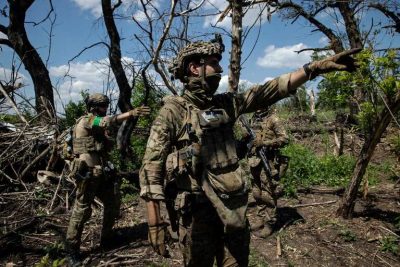New “Thrust” in Ukrainian Counteroffensive Not Enough to Reverse Military Scenario

All Global Research articles can be read in 51 languages by activating the Translate Website button below the author’s name.
To receive Global Research’s Daily Newsletter (selected articles), click here.
Click the share button above to email/forward this article to your friends and colleagues. Follow us on Instagram and Twitter and subscribe to our Telegram Channel. Feel free to repost and share widely Global Research articles.
***
Western media are trying to improve Kiev’s image and create new expectations around the so-called “counteroffensive”. In an article published by the New York Times on July 26, authors stated that “Ukraine has launched the main thrust of its counteroffensive”. It was reported that the Ukrainian authorities had authorized a new war effort, giving an important boost to the operation. At this phase, it is said that a large number of NATO-trained troops are being moved to the front lines. The objective is to gain territory in the regions liberated by the Russians, mainly in the south of the country.
“The United States and other Western allies have trained about 63,000 Ukrainian troops, according to the Pentagon, and have supplied more than 150 modern battle tanks, a much larger number of older tanks, hundreds of infantry fighting vehicles and thousands of other armored vehicles (…) In villages all along the southern front line on Wednesday, unusually heavy artillery fire could be heard as Ukrainian guns thundered from hidden positions and Russian artillery and mortars targeted former Russian positions and villages now occupied by Ukrainian soldiers. Ukrainian troops deployed along that part of the front say they are steadily pushing the Russian troops back in what they describe as step by step, rather than breakthrough, movements”, the article reads.
In fact, the NYT report is in line with what some other newspapers have been saying on the topic recently. For example, CNN published an article on the same day called “Ukraine’s counteroffensive is ramping up after months of slow progress”, in which it is also said that Kiev is deploying well-trained and equipped troops to regain positions currently under control of the Russian armed forces:
“The Ukrainian military had been holding large numbers of trained troops, some equipped with more powerful Western weapons, back since the operation started in early June. While it still maintains some combat power in reserve, it has now deployed the ‘main bulk’ of the forces committed to the counteroffensive forces”, CNN’s text reads.
This information is not entirely false. There is some veracity in the data, as Kiev has indeed recently launched a second phase of its “counteroffensive” against Russian forces.
After the absolute military failure in Donbass, the Ukrainian focus has been on trying to recover some ground in the south, mainly in Zaporozhye. To achieve these strategic objectives, indeed, many NATO-trained troops that until now had been kept in the rear are finally being sent to the frontlines.
Keeping special forces outside the front has been a common Ukrainian practice. Kiev tries to preserve what is left of its military potential by keeping its well-trained troops as long as possible in the rear, while newly recruited and poorly equipped soldiers are sent in large numbers to the “meat grinder” at the frontlines. Kiev allows the deployment of its well-trained forces to the front only at specific times when there is some feasible hope of territorial gain. Currently, Ukraine is betting on the possibility of regaining ground in the south, which explains why forces trained abroad are finally being sent to the region.
It remains to be seen, however, whether the Ukrainian plans will really go as expected by the regime and media. Despite having several NATO-trained troops, the regime is militarily weakened after months of intense fighting. The Russians have created a very solid defensive line with their recent territorial gains, making it difficult for enemy forces to achieve any significant progress.
Also, it must be emphasized that there are a lot of minefields around these Russian-dominated regions. The Ukrainian armed forces are sending large numbers of special forces and NATO military tanks there, which is resulting in heavy losses. As Kiev’s well-trained soldiers die, the regime will be forced to bet once again on sending its inexperienced troops, resulting in new “meat grinders”.
It is unlikely that Ukraine will achieve any relevant territorial gains, except in the event of some strategic retreat by Russian units. Russia’s military advantage will not be easily reversed by simply sending the best troops to the front. In practice, the Ukrainian action sounds more like a gesture of desperation, with the regime sending everything it still has to the lines, trying to gain some ground. Not by chance, a Pentagon official commented on the case classifying the Ukrainian effort as a “big test“.
Even if there is a “thrust”, this does not seem enough to reverse the Russian gains in the conflict. Ukrainian losses so far have been too severe to be compensated by merely deploying a few NATO-trained forces. Wars are not won with just a few special troops, depending also on a strong apparatus of artillery and aviation, in addition to the ability to replace losses. In all these sectors, the Russians continue to have an extreme advantage, which is why Western propaganda about the Zaporozhye offensive sounds like yet another irresponsible attempt to spread expectations of [an impossible] victory.
*
Note to readers: Please click the share button above. Follow us on Instagram and Twitter and subscribe to our Telegram Channel. Feel free to repost and share widely Global Research articles.
Lucas Leiroz is a journalist, researcher at the Center for Geostrategic Studies, geopolitical consultant. You can follow Lucas on Twitter and Telegram.
Featured image is from InfoBrics

